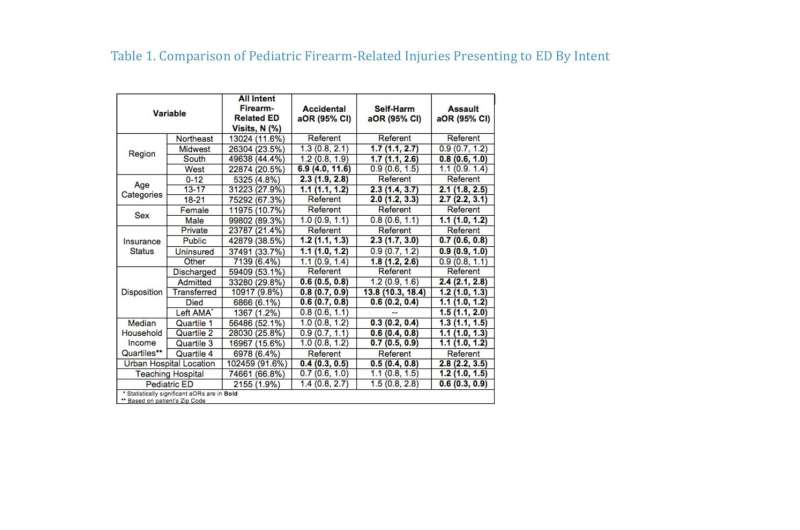Differences in intent of pediatric injuries underscore importance of safe firearm storage

Firearm-related injuries are a leading cause of injury and death in children and adolescents. Knowing more about the differences in the intent of pediatric firearm-related injury, for instance, unintentional injuries compared with injuries related to assault, can guide injury-prevention efforts.
The study abstract, "Emergency Department Visits for Pediatric Firearm-Related Injury: By Intent of Injury," will be presented on Friday, Nov. 2, at the American Academy of Pediatrics 2018 National Conference & Exhibition in Orlando, Fla.
Using a cross-sectional analysis from the Nationwide Emergency Department Sample from 2009 to 2013, researchers examined the records of 111,839 emergency department visits nationwide for pediatric firearm-related injuries.
Excluding visits related to air guns, pellet, BB or paintball guns, injuries treated during these emergency department visits were divided into intent groups: unintentional, assault or self-harm. When injuries were broken down by age, younger children were more likely to sustain unintentional firearm injuries, whereas adolescents were more likely to be victims of firearm-related assault or self-harm.
"Detailed data collection, specifically in relation to situation and context for pediatric firearm-related injuries, could inform efforts to prevent firearm-related injuries. Our study suggests that effective strategies to prevent firearm-related injury in children should focus on age and intent," said Shilpa Patel, MD, MPH, lead study author and assistant professor, Division of Emergency Medicine, Children's National Health System.
A total of 63 percent of injuries were defined as unintentional, 30 percent were categorized as assault and 1 percent were defined as self-harm. Unintentional injury was more common in children 12 years or younger and injuries classified as self-harm or assault were higher in adolescents ages 13 to 21 years.
Other details emerged as well:
- 89 percent of those injured were male, and the average age at injury was 18 years old
- 38 percent of injuries occurred among publicly insured youth
- 30 percent of injuries resulted in hospital admission
- 6 percent of injuries resulted in death
In addition, there were geographic differences in type of firearm injury. Odds of unintentional injury by firearm was higher in the Western region of the U.S. compared with the Northeast, and higher among publicly insured children and teens.
The data also showed that victims of unintentional injuries were more likely to be discharged after treatment, while those with injuries involving assault or self-harm were more likely to be admitted to the hospital and incur higher costs for treatment.
"Pediatricians play an important role in firearm-injury prevention. Pediatricians should continue to counsel families about safe storage of firearms in the home to prevent unintentional firearm-related injuries. Safe firearm storage techniques include trigger locks as well as keeping all firearms locked and unloaded with ammunition locked separately," said Dr. Patel. "Additionally, pediatricians and acute care providers should routinely ask about access to firearms when screening for depression and suicide risks in adolescents and should provide resources on violence prevention."

















